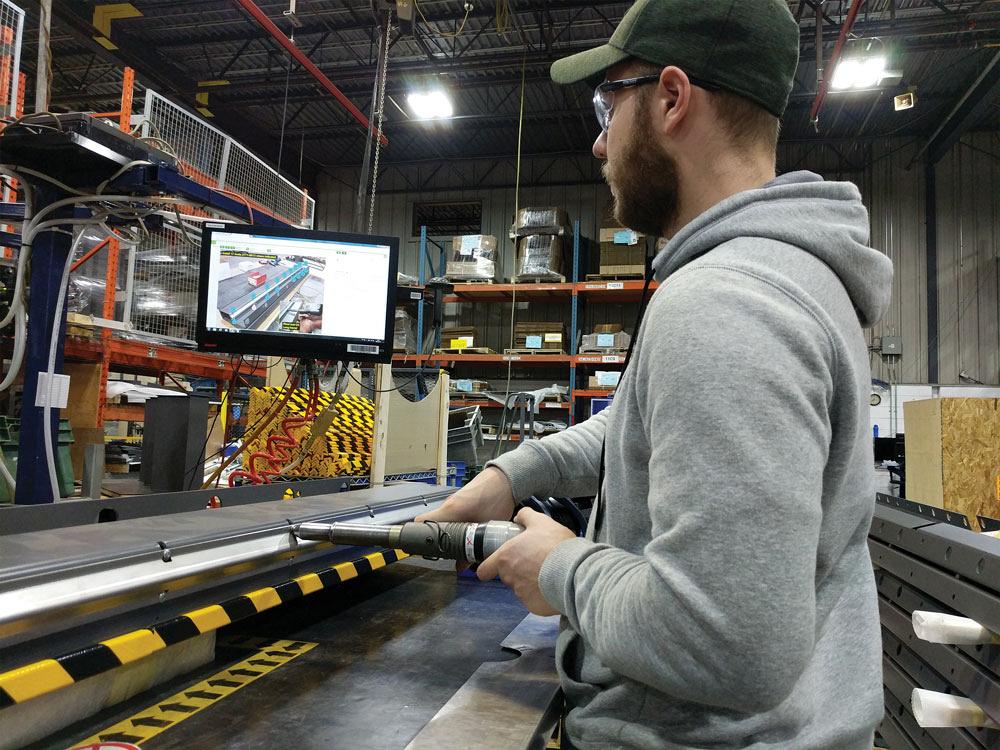Editor
- FMA
- The Fabricator
- FABTECH
- Canadian Metalworking
Assembly meets Industry 4.0
Data gathering at the assembly stage has been growing over the past few years such that it’s no longer the black box element it once was on the shop floor
- By Rob Colman
- April 30, 2019
- Article
- Automation and Software

The information you can capture on the shop floor is increasing regularly, making it possible to monitor production in finer detail. For instance, VKS recently pushed its information-capture abilities further with an add-on module called ToolConnect IoT through which hand tool data can be included in reports. Image courtesy of VKS.
For the past 100 years manufacturers have been fine-tuning the way in which they gather information from the shop floor. Recently this has been revolutionized by the ability to gather real-time information about precisely what each machine is doing at all times.
Capturing information about human activities, however, is more challenging.
“Since the time of Henry Ford, manufacturers have relied on manual time and motion studies, conducted with stopwatches, to gather analytics on human activities,” noted Prasad Akella, founder and CEO of Palo Alto, Cal.-based Drishti, a company that is developing ways in which to make people visible to analytics. “Those studies are the industry standard. But they produce flawed data.
“Here’s why: Imagine if your boss came up behind you with a stopwatch and clipboard. I know how I’d react: I’d probably work really hard to show my boss how great I am. Or, if I was in a different kind of mood, maybe I’d underperform to ensure I’m not held to too high of a standard. Either way, the data my boss would collect wouldn’t reflect my actual performance.”
Akella noted that the other reason this data ends up being flawed is that the sample size is too small – it’s impossible to get a big enough data set with just a handful of time studies.
“What’s worse is the time it takes to gather this data: In a recent survey we conducted with A.T. Kearney, we learned that engineers spend 37 per cent of their time conducting these manual time and motion studies,” Akella continued. “That’s more than 59 hours a month, or nearly a full workweek and a half, all devoted to time and motion studies that yield inaccurate data anyway.”
As Akella also said, this means that manufacturers have been using flawed data to make major business decisions. The challenge has been to find some way in which to address this.
Work Instruction Revolution
Fixing this dearth of data is beginning to be tackled through technology like digital work instruction programs. Montreal-based VKS is a good example of just such a system. The company began as an offshoot of a high-mix, low-volume contract manufacturer. That company was looking into ways in which it could improve throughput while reducing training time. The VKS work instruction software was the upshot of this need.
The VKS software provides step-by-step instructions to employees for each assembly they are working on. While this in itself was a valuable tool, it also created a platform through which quality checks and part traceability could be integrated.
“Through VKS companies can create digital forms that allow the employee to complete a quality check right in the program rather than filling out a paper form,” said Ryan Zimmermann, VKS director of business development. “In a non-regulated industry, an employee might just use a form to confirm that all the necessary parts are present to complete an assembly. For regulated industries like aerospace or medical, a quality check might be triggered at certain points of an assembly to ensure each assembly meets industry requirements. These checks also create a thorough device history record, which is critical for some companies. Basically, this has created higher degrees of process control and traceability.”
The company recently pushed its information-capture abilities further with an add-on module called ToolConnect IoT through which hand tool data can be included in reports.
“ToolConnect IoT uses the Open Protocol exchange format originally developed by Atlas Copco and creates a safe communication portal from your assembly tools to our software,” said Zimmermann. “So if an assembly has torque requirements that need to be reported, the system will ensure that that torque value is registered for each screw. If a screw doesn’t meet torque requirements, the system will show red and the work instruction won’t move forward until the issue is addressed.”
Time to Completion
In addition to this detailed knowledge of what has been done and to what standard, another critical piece of information is naturally included with this substantial digital paper trail – time to completion of each function.
“Even if you are not doing quality checks along the way, it’s possible to include a function in the program to have an operator report on precisely how many assemblies they have completed after a variety of intervals,” said Zimmermann. “This knowledge of the speed at which job completion is achieved can help with planning and quoting. But it also can be used as a learning tool. For instance, if there are one or two people who really excel in their assembly speeds, managers could review how they are performing their work and collaborate with them to document the process and share the teachable techniques with the rest of the workforce through VKS to raise everyone’s productivity to similar levels.“
Enter AI
Understanding how employees do their jobs on the shop floor by actually calculating their movements is where Drishti is taking shop floor data to a different level.
“Our system, quite simply, uses computer vision at every station to automatically digitize actions that the line associates are taking – in the very variable order humans are wont to take them,” said Akella.
“Why take this apparently contrarian approach instead of forcing the line associate to adhere to a predetermined pattern? Because we believe that the line associate often knows a thing or two that the process engineer who designed the process in the first place doesn’t,” he continued. “Because we believe that the creativity of the individual human being has to be celebrated – the ‘brilliant outliers,’ as we refer to them. And, because we can answer a slew of questions like those that you just framed up.”
In a way, Drishti and VKS are coming at this particular challenge from two different directions – both trying to capture optimal processes by capturing the optimal performers in the shop via different data.
“What’s unique in our process is the data we are gathering and making available to our customers, as well as the scale at which we are delivering it,” said Akella. “Our customers now have thousands of data points where in the past they were lucky to have tens. With this volume of data, you can understand your process in far richer ways, which naturally changes how you measure your process and illuminates some pretty significant opportunities.”
For companies producing parts globally, the concept is like “enabling the virtual genba,” said Akella, it delivers the plant floor to your desk. It also delivers statistics to all the players involved.
“Our system helps process engineers, supervisors, and, significantly, operators themselves with gross and fine measurements,” said Akella. “For the operator, we push real-time, in-station notifications that alert him or her to process deviations, missed steps, or other kinds of anomalies. For supervisors and engineers, we present easily digestible insights that highlight trends, outliers, deviations, and potential improvements. Every data point is backed by video documentation that quickly illustrates the cause of any statistical anomalies.”
Akella recognizes that bringing AI to the shop floor is something that will be akin to the revolution created with Ford’s introduction of mass production, and the concept will take some getting used to.
“We are, therefore, building on lean and the Toyota Production System, which generations of manufacturing experts intuitively understand and use,” said Akella. “What we are doing is helping manufacturers wrap their heads around a new paradigm for solving problems: using deep data-driven insights to solve old problems. We are finding that once the (lead) engineers at our customers internalize what the data can tell them and how they can explore and use the data, they’re off to the races. In many cases, our customers are using the data in ways we haven’t even imagined – in effect, they’re the ones who are teaching us.”
Handle With Care
Zimmermann concedes that any technology that captures employee actions with such minute detail is going to concern shop employees if not approached with care.
“This kind of technology is there to capture best practices in a way that just wasn’t possible 20 years ago,” he said. “It’s important to use it in such a way that it celebrates the best of what an organization does.”
Continuous improvement initiatives in assembly processes are changing to match the pace of Industry 4.0. Taking the right approach in your operations can add value that has remained hidden for many years.
Editor Robert Colman can be reached at rcolman@canadianfabweld.com.
About the Author

Rob Colman
1154 Warden Avenue
Toronto, M1R 0A1 Canada
905-235-0471
Robert Colman has worked as a writer and editor for more than 25 years, covering the needs of a variety of trades. He has been dedicated to the metalworking industry for the past 13 years, serving as editor for Metalworking Production & Purchasing (MP&P) and, since January 2016, the editor of Canadian Fabricating & Welding. He graduated with a B.A. degree from McGill University and a Master’s degree from UBC.
subscribe now


Keep up to date with the latest news, events, and technology for all things metal from our pair of monthly magazines written specifically for Canadian manufacturers!
Start Your Free Subscription- Trending Articles
Aluminum MIG welding wire upgraded with a proprietary and patented surface treatment technology

CWB Group launches full-cycle assessment and training program

Achieving success with mechanized plasma cutting

Hypertherm Associates partners with Rapyuta Robotics

Brushless copper tubing cutter adjusts to ODs up to 2-1/8 in.

- Industry Events
MME Winnipeg
- April 30, 2024
- Winnipeg, ON Canada
CTMA Economic Uncertainty: Helping You Navigate Windsor Seminar
- April 30, 2024
- Windsor, ON Canada
CTMA Economic Uncertainty: Helping You Navigate Kitchener Seminar
- May 2, 2024
- Kitchener, ON Canada
Automate 2024
- May 6 - 9, 2024
- Chicago, IL
ANCA Open House
- May 7 - 8, 2024
- Wixom, MI


















